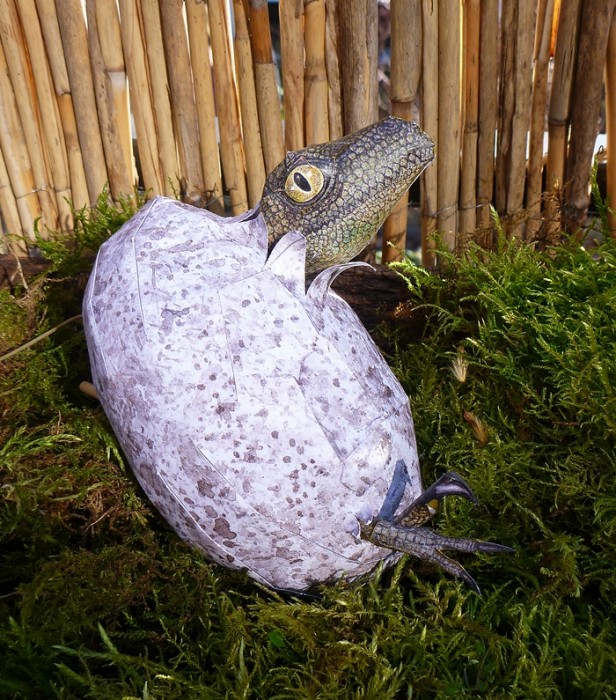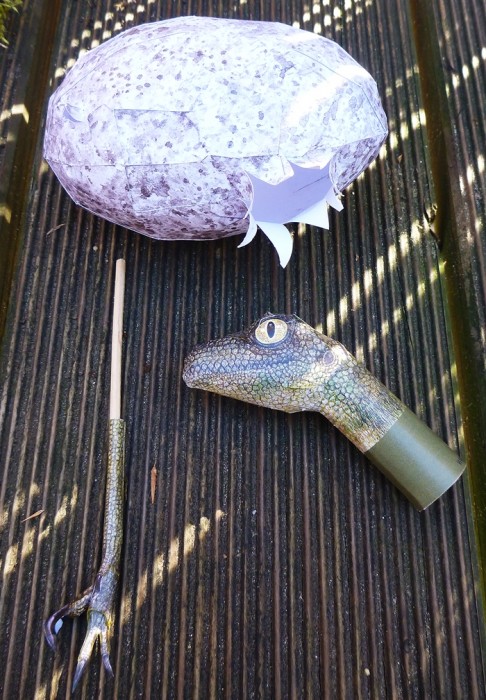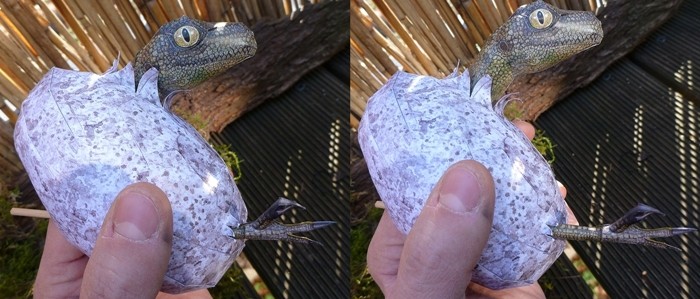Review and photos by Lanthanotus, edited by Suspsy
Following my review about the Styracosaurus hatched from a chocolate surprise egg, I’ll introduce you to a “real” hatchling in this review, just the right thing to put some Mesozoic spice to your upcoming Easter celebrations–the model of hatching Deinonychus by talented Netherlands artist Johan Scherft.

Now, where to start with this unusual review for a blog dedicated to dino toys? I certainly don’t have to tell you anything about Deinonychus as a species. This inconspicuous-looking model includes an action feature putting those Jurassic World Bashers & Biters plastics to shame: the young Deinonychus can move as if hatching for real! But first things first, a review has to describe what we have here.

The above mentioned action feature is somewhat surprising when you realize that the hatching Deinonychus is a papercraft model. The assembly may be somewhat challenging depending on your skills and experience with papercrafts–it’s no magic though. The model comes as a two page, colored PDF which you’d have to print on a sheet of paper of fitting quality (80 to 120 gram) and cut out carefully with sharp scissors and an Exacto knife. To further assemble the model, you’d need transparent glue, skewers, and tweezers, as there’s some very small tips to fit together. Detailed video instructions are provided by the artist but the experienced modeller should have no problem reading the template to assemble the model successfully.

The original template is drawn and colored manually by the artist and the model boasts a lot of detail, especially when looking at the bright, yellow eyes and sickle clawed foot. The overall coloration isn’t very intriguing, but after all, there’s not a whole lot to see of the hatchling’s body and green is a good coloration for a small young dino in desperate need of some camouflage. The egg itself is of white base color sprinkled with grey brown blotches of varying size. The design of this papercraft model is very fine and detailed and from a distance you can hardly tell it apart from a sculpted, solid model.

When it comes to scientific accuracy, one may have two major things to complain. First: the absence of feathers, though the artist does them really well and most of his models are indeed avian dinosaurs of the Neornithes lineage. Second: the vertical pupils typical for a nocturnal animal. Despite being aware of recent scientific knowledge, I like most of my dinos scaled and featherless. Call me a child of the 80s’, but I couldn’t care less about this Deinonychus being scaled. The slit pupils don’t bother me either as they look quite good on this small dromaeosaurid, and as some scientists deem the large-eyed Troodon nocturnal, who’s to say for sure that the also relatively large-eyed Deinonychus wasn’t?
While the hatching Deinonychus makes a nice display model when fit to some kind of base or better into some nest, it makes an even greater toy, especially when you’ve got a kid with a love for dinosaurs. In addition to the two grooves where the raptor sticks out its head and foot, the egg shell has a big hole on the back where you are supposed to stick your trigger finger in and put the neck of the creature’s head onto your finger’s tip. The foot’s extension sticks out the hole and lies next to your finger allowing you combined or separate movement of the Deinonychus‘ head and foot with just one finger, depending on your skill (see the artist presenting his model). It may require a bit of training, but the effect is really nice and not just children will be amazed by this cute fellow trying to get out of his chalky prison.
Johan Scherft generously provides the template of this model for free download here and while you’re at it, have a look for the rest of this astonishing art. Another one of his models will be reviewed soon, so get your scissors ready.
Disclaimer: links to Ebay and Amazon on the DinoToyBlog are affiliate links, so we make a small commission if you use them. Thanks for supporting us!




[…] It’s been a while since I promised you another review of a papercraft model, but here it is, Johan Scherft’s interpretation of Microceratops. Now, if you wonder why this name isn’t italicised here or why Google redirects you to a species of parasitic wasp rather than to a ceratopsian dinosaur the explanation is, that Microceratops is in fact an insect species and because of this, the few small parts of a ceratopsian dinosaur fossil found in Mongolia and decribed 1953 by Bohlin were renamed Microceratus by Mateus in 2008. However, some scientists regard Microceratus as a nomen dubuim because most of the fossil material was reassigned to Graciliceratops, a small species that belonged to the Protoceratopsidae and dwelled in Mongolia some 86 to 72 million years ago. So for the sake of this review, let’s just say that we’re talking about a small and early ceratopsian, and for this, the model presented here convinces. […]
That’s very cute!